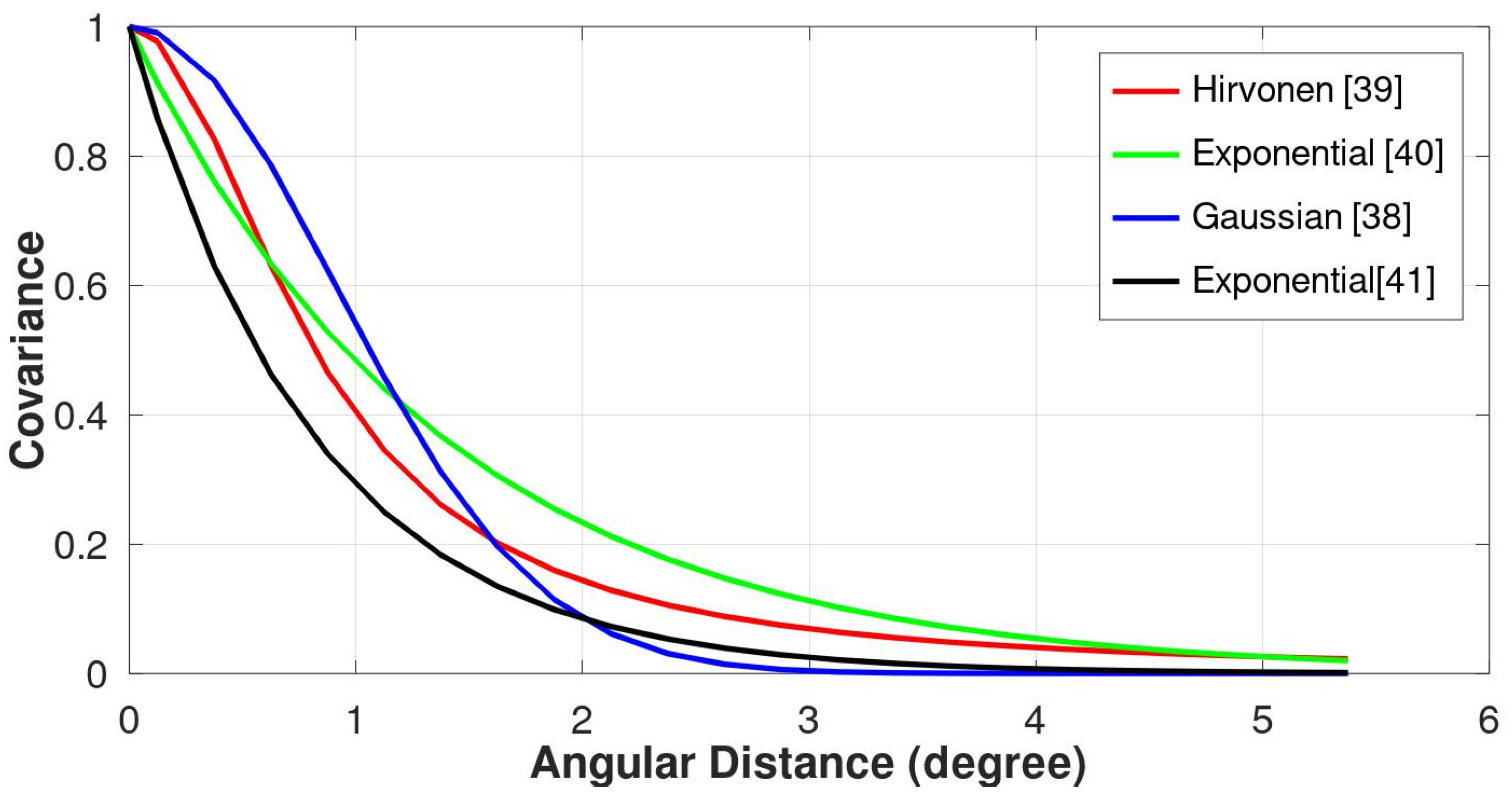Least Squares Collocation for Estimating Terrestrial Water Storage Variations from GNSS Vertical Displacement on the Island of Haiti
Abstract
1. Introduction
2. Materials and Methods
2.1. Least Squares Collocation: Basic Formulation
2.2. Problem Characterization
2.3. Analytical Covariance Function Determination
2.4. GNSS Network
3. Results and Discussion
3.1. Simulated Data Result
Data Resolution Test
3.2. Error Estimate Test
3.2.1. Stability Test
3.2.2. Robustness Test
3.3. Real GNSS Data Result
3.3.1. Spatiotemporal Result
3.3.2. Temporal Inversion by Cell
4. Conclusions
Author Contributions
Funding
Data Availability Statement
Acknowledgments
Conflicts of Interest
References
- Tapley, B.D. The Gravity Recovery and Climate Experiment: Mission overview and early results. Geophys. Res. Lett. 2004, 31, L09607. [Google Scholar] [CrossRef]
- Wahr, J.; Swenson, S.; Zlotnicki, V.; Velicogna, I. Time-variable gravity from GRACE: First results. Geophys. Res. Lett. 2004, 31, L11501. [Google Scholar] [CrossRef]
- Blewitt, G.; Lavallée, D.; Clarke, P.; Nurutdinov, K. A New Global Mode of Earth Deformation Seasonal Cycle Detected. Science 2001, 294, 2342–2345. [Google Scholar] [CrossRef] [PubMed]
- Davis, J.L.; Elósegui, P.; Mitrovica, J.X.; Tamisiea, M.E. Climate-Driven Deformation of the Solid Earth from GRACE and GPS. Geophys. Res. Lett. 2004, 31, L24605. [Google Scholar] [CrossRef]
- Kusche, J.; Schrama, E.J.O. Surface Mass Redistribution Inversion from Global GPS Deformation and Gravity Recovery and Climate Experiment (GRACE) Gravity Data: Surface Mass Redistribution from GPS and GRACE. J. Geophys. Res. Solid Earth 2005, 110. [Google Scholar] [CrossRef]
- Tregoning, P.; Watson, C.; Ramillien, G.; McQueen, H.; Zhang, J. Detecting Hydrologic Deformation Using GRACE and GPS: Hydrologic Deformation from Space. Geophys. Res. Lett. 2009, 36. [Google Scholar] [CrossRef]
- Nahmani, S.; Bock, O.; Bouin, M.-N.; Santamaría-Gómez, A.; Boy, J.-P.; Collilieux, X.; Métivier, L.; Panet, I.; Genthon, P.; de Linage, C.; et al. Hydrological Deformation Induced by the West African Monsoon: Comparison of GPS, GRACE and Loading Models: Hydrological Deformation in West Africa. J. Geophys. Res. Solid Earth 2012, 117. [Google Scholar] [CrossRef]
- Fu, Y.; Freymueller, J.T.; Jensen, T. Seasonal Hydrological Loading in Southern Alaska Observed by GPS and GRACE. Geophys. Res. Lett. 2012, 39. [Google Scholar] [CrossRef]
- Fritsche, M.; Döll, P.; Dietrich, R. Global-Scale Validation of Model-Based Load Deformation of the Earth’s Crust from Continental Watermass and Atmospheric Pressure Variations Using GPS. J. Geodyn. Mass Transp. Mass Distrib. Syst. Earth 2012, 59–60, 133–142. [Google Scholar] [CrossRef]
- Doll, P.; Kaspar, F.; Bernhard, L. A global hydrological model for deriving water availability indicators: Model tuning and validation. J. Hydrol. 2003, 270, 105–134. [Google Scholar] [CrossRef]
- Sauveur, R.; Tabibi, S.; Francis, O. Hydrological Loading in GNSS Vertical Coordinate Time Series on the Island of Haiti. Pure Appl. Geophys. 2024, 181, 3591–3604. [Google Scholar] [CrossRef]
- Wu, X.; Heflin, M.B.; Ivins, E.R.; Argus, D.F.; Webb, F.H. Large-Scale Global Surface Mass Variations Inferred from GPS Measurements of Load-Induced Deformation. Geophys. Res. Lett. 2003, 30. [Google Scholar] [CrossRef]
- Ferreira, V.; Ndehedehe, C.E.; Montecino, H.C.; Yong, B.; Yuan, P.; Abdalla, A.; Mohammed, A.S. Prospects for Imaging Terrestrial Water Storage in South America Using Daily GPS Observations. Remote Sens. 2019, 11, 679. [Google Scholar] [CrossRef]
- Argus, D.F.; Fu, Y.; Landerer, F.W. Seasonal Variation in Total Water Storage in California Inferred from GPS Observations of Vertical Land Motion. Argus. Geophys. Res. Lett. 2014, 41, 1971–1980. [Google Scholar] [CrossRef]
- Adusumilli, S.; Borsa, A.A.; Fish, M.A.; McMillan, H.K.; Silverii, F. A Decade of Water Storage Changes Across the Contiguous United States from GPS and Satellite Gravity. Geophys. Res. Lett. 2019, 46, 13006–13015. [Google Scholar] [CrossRef]
- Milliner, C.; Materna, K.; Bürgmann, R.; Fu, Y.; Moore, A.W.; Bekaert, D.; Adhikari, S.; Argus, D.F. Tracking the Weight of Hurricane Harvey’s Stormwater Using GPS Data. Sci. Adv. 2018, 4, 2477. [Google Scholar] [CrossRef]
- Tarantola, A. Inverse Problem Theory and Methods for Model Parameter Estimation. 2005. Available online: https://epubs.siam.org/doi/book/10.1137/1.9780898717921 (accessed on 13 August 2025).
- Aster, R.C.; Borchers, B.; Thurber, C.H. Rank Deficiency and Ill-Conditioning. In Parameter Estimation and Inverse Problems; Elsevier: Amsterdam, The Netherlands, 2019; pp. 55–91. [Google Scholar] [CrossRef]
- Menke, W. Geophysical Data Analysis: Discrete Inverse Theory, 4th ed.; Elsevier Ltd.: London, UK, 2018. [Google Scholar]
- Tikhonov, N.; Goncharsky, A.; Stepanov, V.V.; Yagola, A.G. Numerical Methods for the Solution of Ill-Posed Problems; Springer Science & Business Media: Berlin/Heidelberg, Germany, 1995. [Google Scholar]
- Fu, Y.; Argus, D.F.; Landerer, F.W. GPS as an Independent Measurement to Estimate Terrestrial Water Storage Variations in Washington and Oregon. J. Geophys. Res. Solid Earth 2015, 120, 552–566. [Google Scholar] [CrossRef]
- Fok, H.S.; Liu, Y. An Improved GPS-Inferred Seasonal Terrestrial Water Storage Using Terrain-Corrected Vertical Crustal Displacements Constrained by GRACE. Remote Sens. 2019, 11, 1433. [Google Scholar] [CrossRef]
- Young, Z.M.; Kreemer, C.; Blewitt, G. GPS Constraints on Drought-Induced Groundwater Loss Around Great Salt Lake, Utah, with Implications for Seismicity Modulation. J. Geophys. Res. Solid Earth 2021, 126, 022020. [Google Scholar] [CrossRef]
- Jiang, Z.; Hsu, Y.-J.; Yuan, L.; Huang, D. Monitoring Time-Varying Terrestrial Water Storage Changes Using Daily GNSS Measurements in Yunnan, Southwest China. Remote Sens. Environ. 2021, 254, 112249. [Google Scholar] [CrossRef]
- Hsu, Y.-J.; Fu, Y.; Bürgmann, R.; Hsu, S.-Y.; Lin, C.-C.; Tang, C.-H.; Wu, Y.-M. Assessing Seasonal and Interannual Water Storage Variations in Taiwan Using Geodetic and Hydrological Data. Earth Planet. Sci. Lett. 2020, 550, 116532. [Google Scholar] [CrossRef]
- Enzminger, T.L.; Small, E.E.; Borsa, A.A. Accuracy of Snow Water Equivalent Estimated from GPS Vertical Displacements: A Synthetic Loading Case Study for Western U.S. Mt. Water Resour. Res. 2018, 54, 581–599. [Google Scholar] [CrossRef]
- Borsa, A.A.; Agnew, D.C.; Cayan, D.R. Ongoing Drought-Induced Uplift in the Western United States. Science 2014, 345, 1587–1590. [Google Scholar] [CrossRef]
- Lai, Y.R.; Wang, L.; Bevis, M.; Fok, H.S.; Alanazi, A. Truncated Singular Value Decomposition Regularization for Estimating Terrestrial Water Storage Changes Using GPS: A Case Study over Taiwan. Remote Sens. 2020, 12, 3861. [Google Scholar] [CrossRef]
- Bo, Z.; XianPao, L.I.; JianCheng, L.I.; HaiHong, W.; Jian, D. Inversion of regional terrestrial water storage changes using GPS vertical displacements based on TSVD-Tikhonov regularization method. Chin. J. Geophys. Chin. 2023, 66, 997–1014. [Google Scholar] [CrossRef]
- Li, X.; Zhong, B.; Li, J.; Liu, R. Inversion of terrestrial water storage changes from GNSS vertical displacements using a priori constraint: A case study of the Yunnan Province. China J. Hydrol. 2023, 617, 129126. [Google Scholar] [CrossRef]
- Krarup, T. A Contribution to the Mathematical Foundation of Physical Geodesy. Geod Inst Cph. 1969, 44, 80. Available online: https://ui.adsabs.harvard.edu/abs/1969MeGIC..44.....K (accessed on 13 August 2025).
- El-Fiky, G.S.; Kato, T.; Fujii, Y. Distribution of Vertical Crustal Movement Rates in the Tohoku District, Japan, Predicted by Least-Squares Collocation. J. Geod. 1997, 71, 432–442. [Google Scholar] [CrossRef]
- Vergos, G.S.; Tziavos, I.N.; Andritsanos, V.D. On the Determination of Marine Geoid Models by Least-Squares Collocation and Spectral Methods Using Heterogeneous Data. In A Window on the Future of Geodesy; Sansò, F., Ed.; International Association of Geodesy Symposia: Berlin/Heidelberg, Germany, 2005; pp. 332–337. [Google Scholar] [CrossRef]
- Mikhail, E.M.; Ackermann, F.E. Observations and least squares. In The IEP Series in Civil Engineering; IEP: New York, NY, USA, 1976. [Google Scholar]
- Collier, P.A.; Argeseanu, V.S.; Leahy, F.J. Distortion Modelling and the Transition to GDA94. Aust. Surv. 1998, 43, 29–40. [Google Scholar] [CrossRef]
- Moritz, H. Advanced Physical Geodesy; Abacus Press: New York, NY, USA, 1980. [Google Scholar]
- Goovaerts, P. Geostatistics for Natural Resources Evaluation; Oxford University Press: New York, NY, USA; Oxford, UK, 1997. [Google Scholar]
- Francis, O. Introduction aux Problèmes Inverses, Observatoire, (tech. rep., 1991). Available online: https://www.academia.edu/120080324/Introduction_aux_Probl%C3%A8mes_Inverses (accessed on 13 August 2025).
- Moritz, H. Covariance Functions—School of Earth Sciences. 1976. Available online: https://geology.osu.edu/sites/earthsciences.osu.edu/files/report-240.pdf (accessed on 13 August 2025).
- Duquenne, H.; Everaerts, M.; Lambot, P. Merging a Gravimetric Model of the Geoid with GPS/Levelling data: An Example in Belgium. In Gravity, Geoid and Space Missions; Jekeli, C., Bastos, L., Fernandes, J., Eds.; Springer: Berlin, Germany, 2005; pp. 131–136. [Google Scholar]
- Shaw, L.; Paul, I.; Henrikson, P. Statistical models for the vertical deflection from gravity-anomaly models. J. Geophys. Res. 1969, 74, 4259–4265. [Google Scholar] [CrossRef]
- Farrell, W.E. Deformation of the Earth by Surface Loads. Rev. Geophys. 1972, 10, 761. [Google Scholar] [CrossRef]
- Gneiting, T.; Kleiber, W.; Schlather, M. Matérn Cross-Covariance Functions for Multivariate Random Fields. J. Am. Stat. Assoc. 2010, 11, 1167–1177. [Google Scholar] [CrossRef]
- Tabibi, S.; Sauveur, R.; Guerrier, K.; Metayer, G.; Francis, O. SNR-Based GNSS-R for Coastal Sea-Level Altimetry. Geosciences 2021, 11, 391. [Google Scholar] [CrossRef]
- Sauveur, R. Estimating Terrestrial Water Storage Variations from GNSS Vertical Displacements in the Island of Haiti. Ph.D. Thesis, Unilu—University of Luxembourg, Luxembourg, 2023. Available online: https://orbilu.uni.lu/handle/10993/55102 (accessed on 13 August 2025).
- van Dam, T.; Wahr, J.; Milly, P.C.D.; Shmakin, A.B. Crustal Displacements Due to Continental Water Loading. Geophys. Res. Lett. 2001, 28, 651–654. [Google Scholar] [CrossRef]
- Yin, G.; Forman, B.A.; Loomis, B.D.; Luthcke, S.B. Comparison of Vertical Surface Deformation Estimates Derived From Space-Based Gravimetry, Ground-Based GPS, and Model-Based Hydrologic Loading Over Snow-Dominated Watersheds in the United States. J. Geophys. Res. Solid Earth 2020, 125, e2020JB019432. [Google Scholar] [CrossRef]
- Tarantola, A.; Valette, B. Generalized Nonlinear Inverse Problems Solved Using the Least Squares Criterion. Rev. Geophys. 1982, 20, 219. [Google Scholar] [CrossRef]
- Mosegaard, K.; Tarantola, A. Probabilistic Approach to Inverse Problems. In International Geophysics; Academic Press: Cambridge, MA, USA, 2002. [Google Scholar]
- Van Camp, M.; Vauterin, P. Tsoft: Graphical and interactive software for the analysis of time series and Earth tides. Comput. Geosci. 2005, 31, 631–640. [Google Scholar] [CrossRef]
- Herring, T.A.; King, R.W.; Floyd, M.A.; McClusky, S.C. Introduction to GAMIT/GLOBK, Release 10.7. Massachusetts Institute of Technology, Department of Earth, Atmospheric and Planetary Sciences, Technical Report, 2018. Available online: http://geoweb.mit.edu/gg/Intro_GG.pdf (accessed on 13 August 2025).
- Rodell, M.; Houser, P.R.; Jambor, U.; Gottschalck, J.; Mitchell, K.; Meng, C.-J.; Arsenault, K.; Cosgrove, B.; Radakovich, J.; Bosilovich, M.; et al. The Global Land Data Assimilation System. Bull. Am. Meteorol. Soc. 2004, 85, 381–394. [Google Scholar] [CrossRef]
- Wessel, P.; Luis, J.F.; Uieda, L.; Scharroo, R.; Wobbe, F.; Smith, W.H.F.; Tian, D. The Generic Mapping Tools version 6. Geochem. Geophys. Geosyst. 2019, 20, 5556–5564. [Google Scholar] [CrossRef]

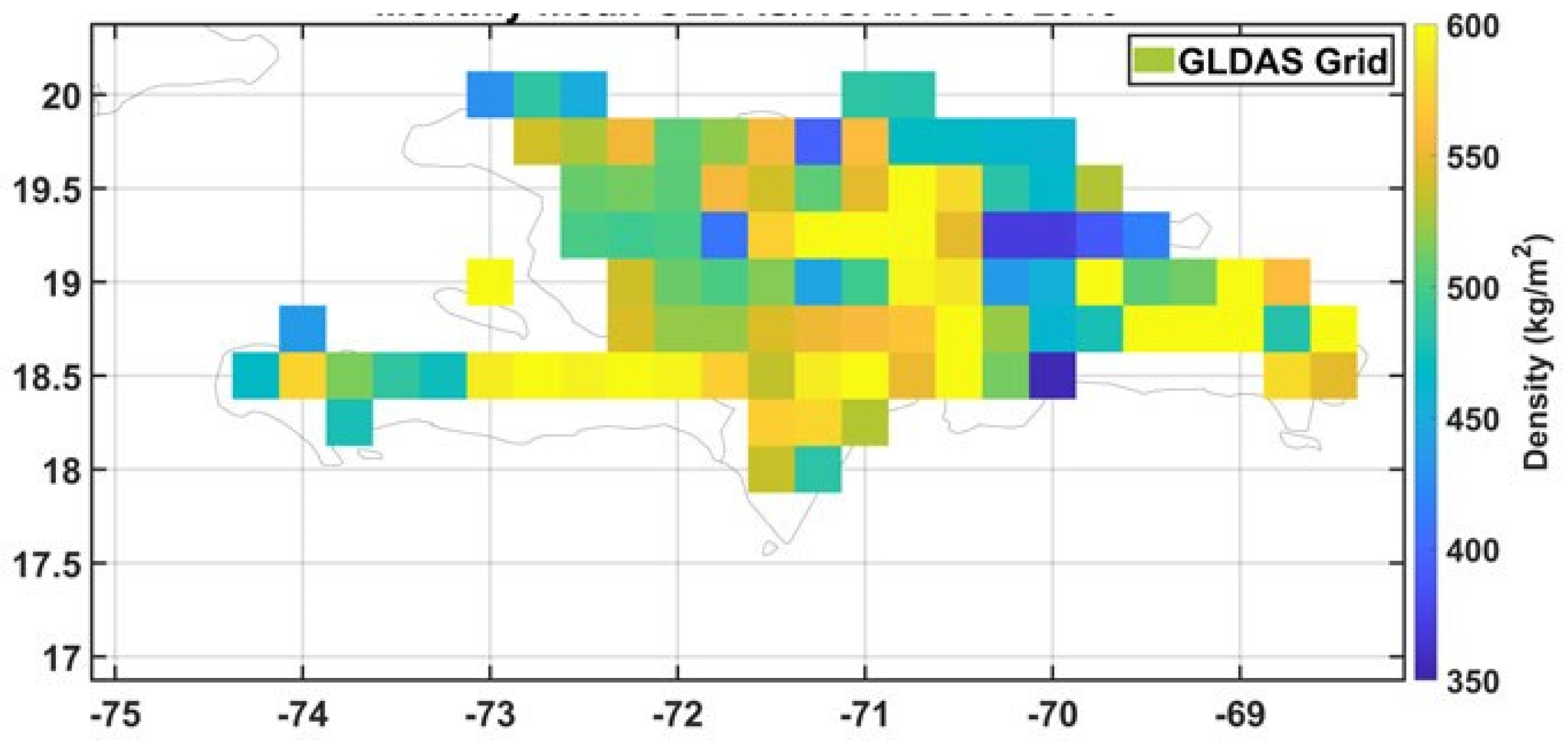
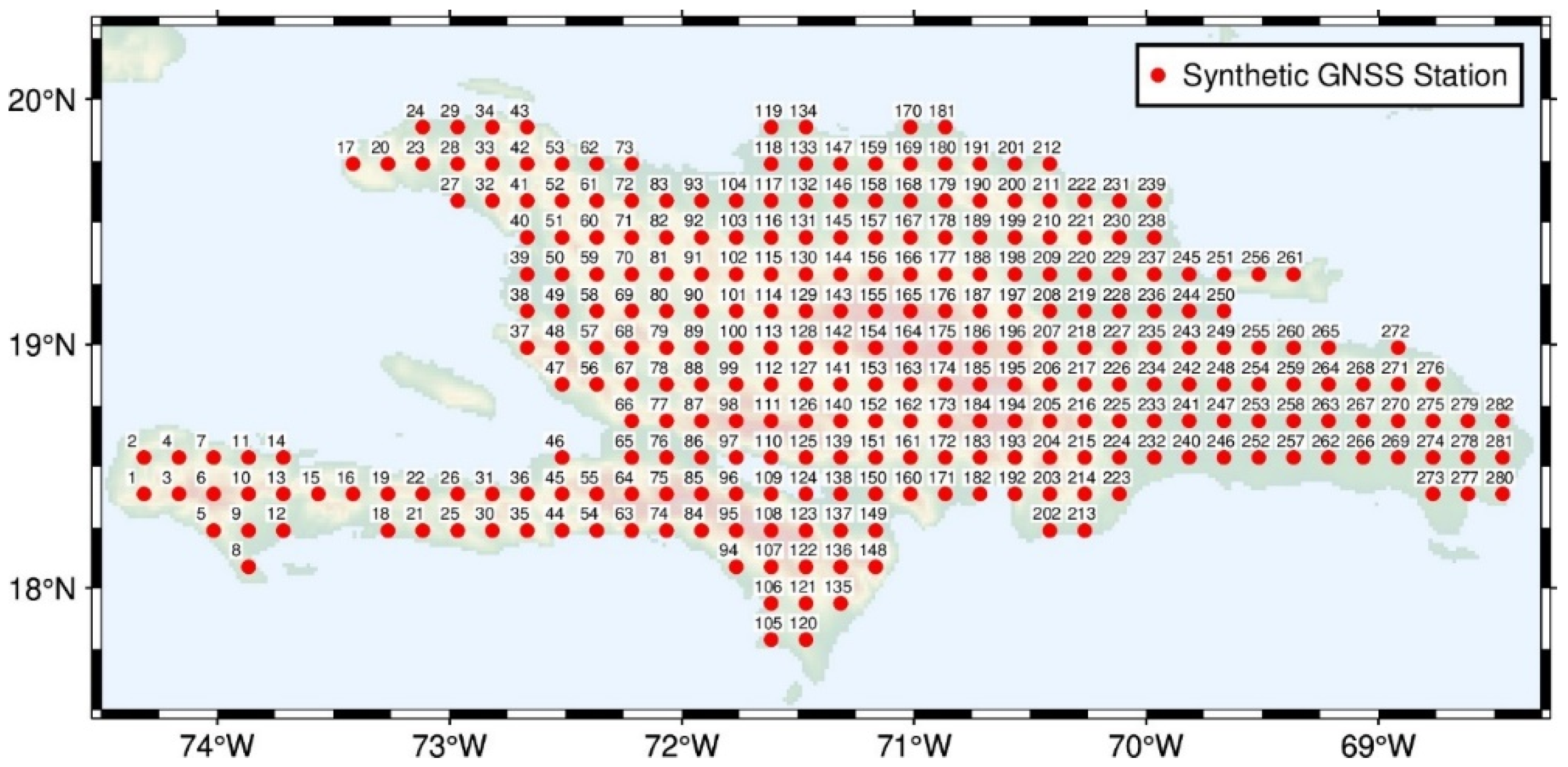
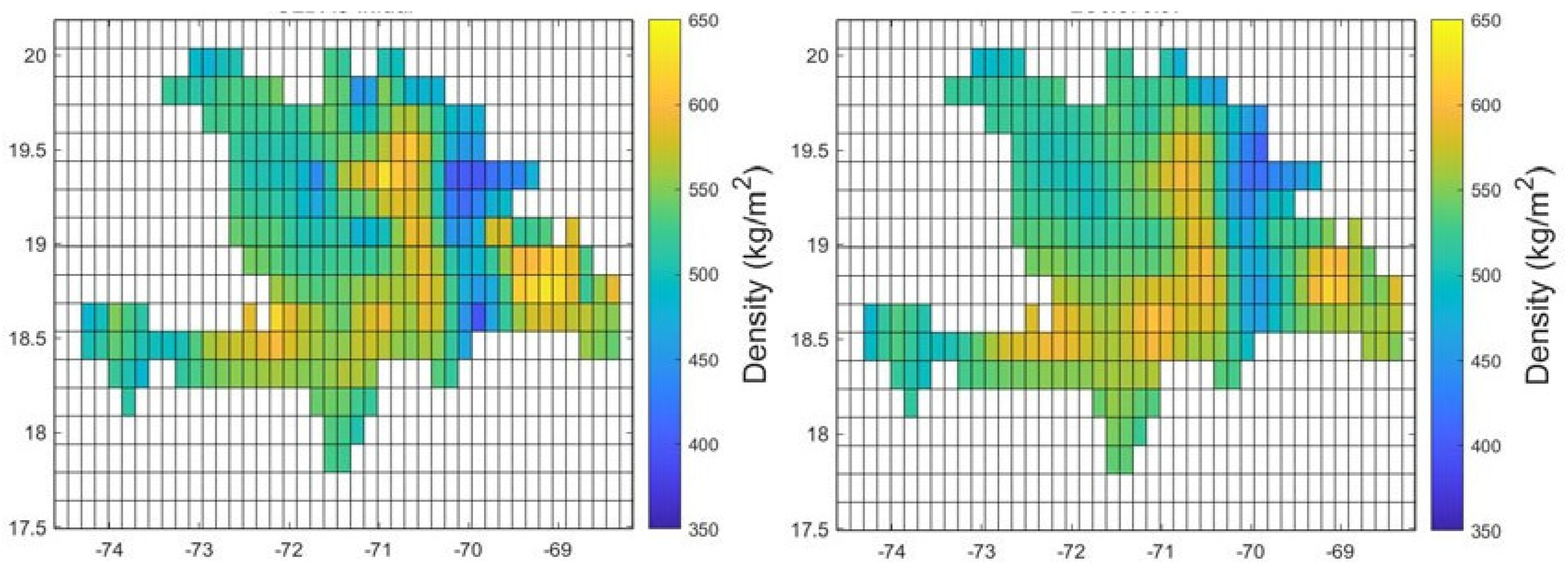
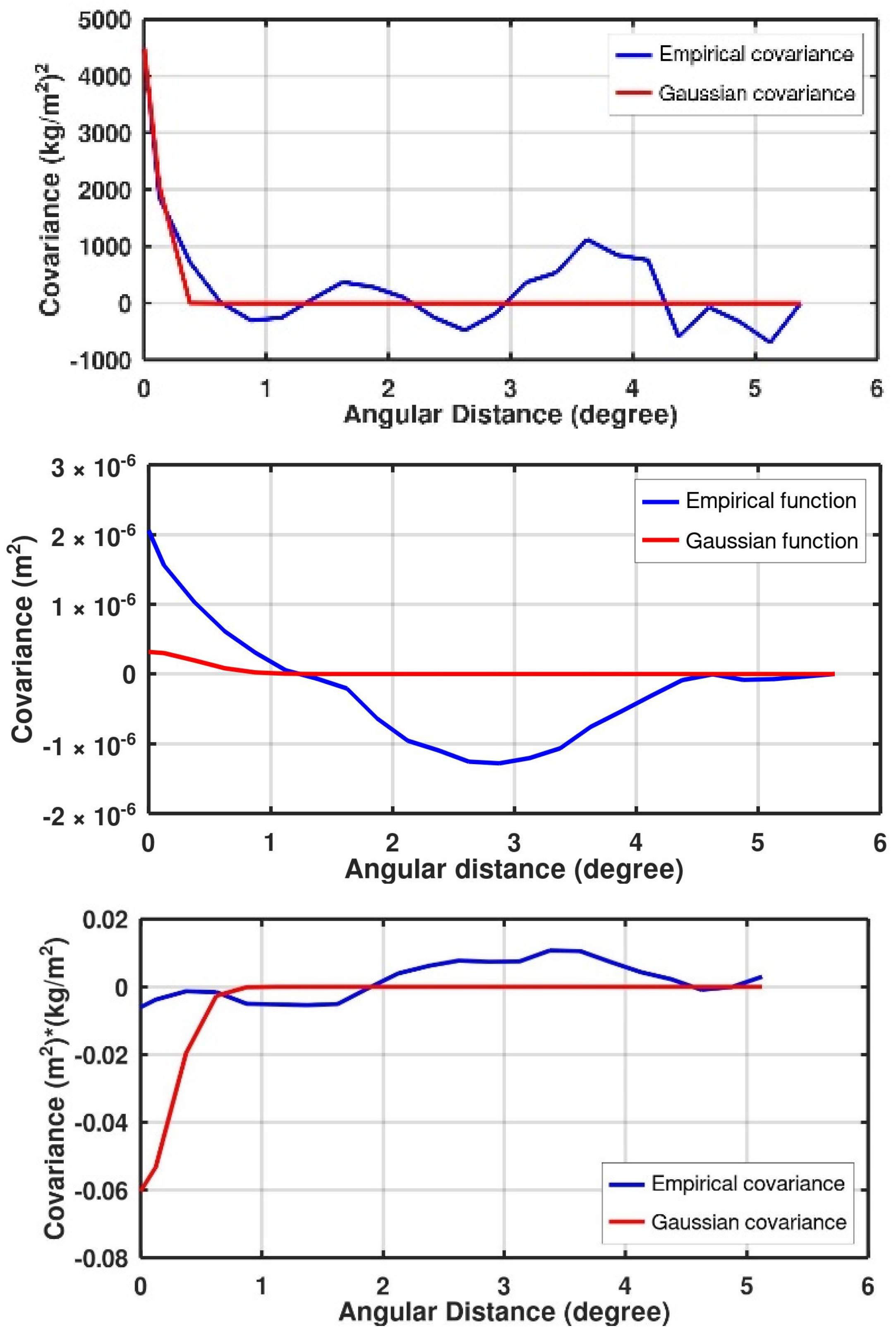
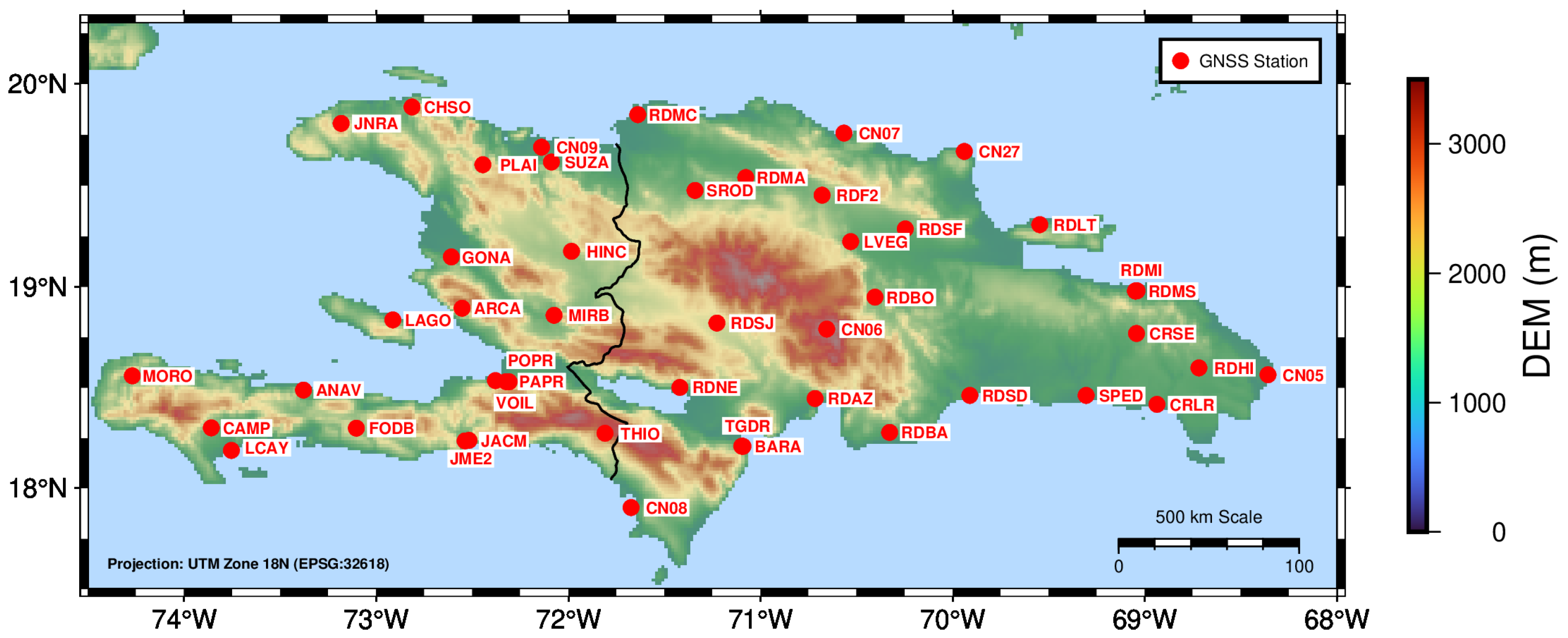




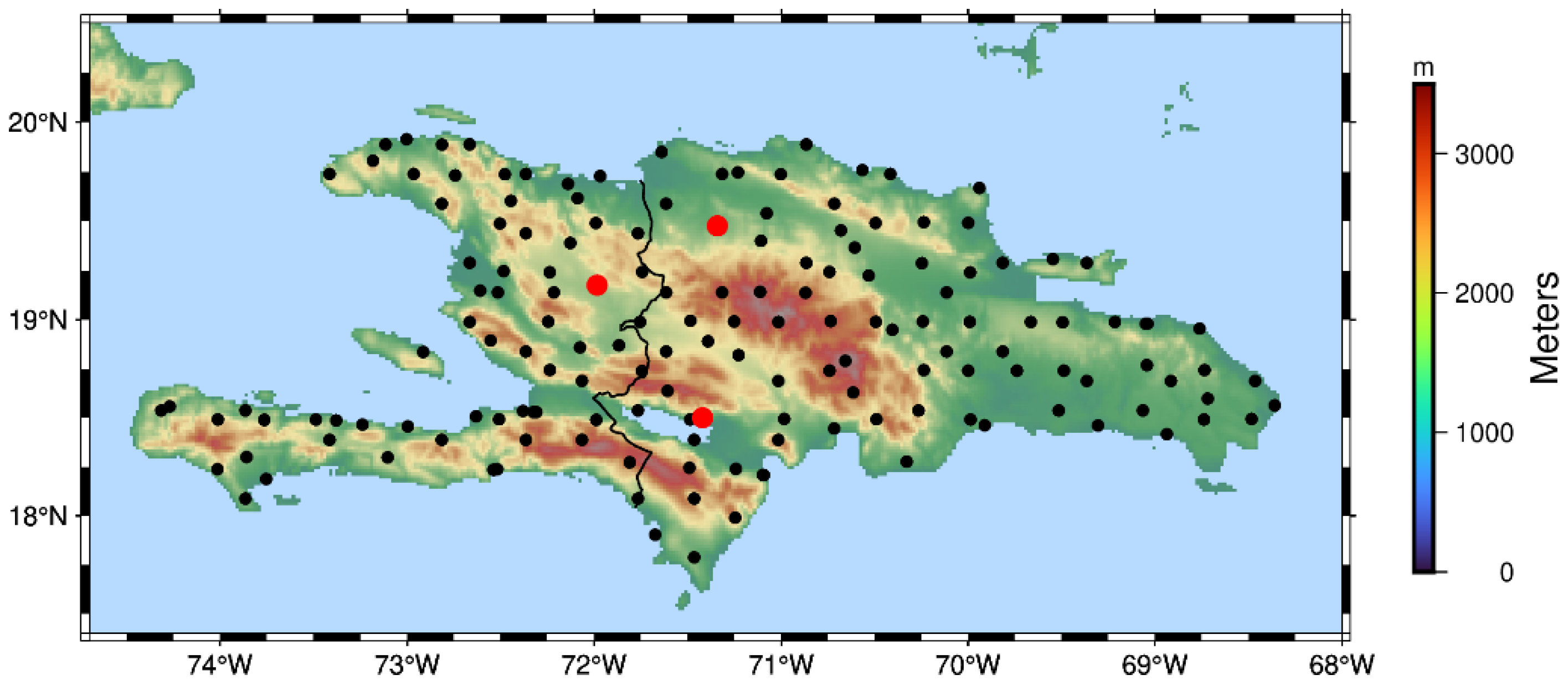
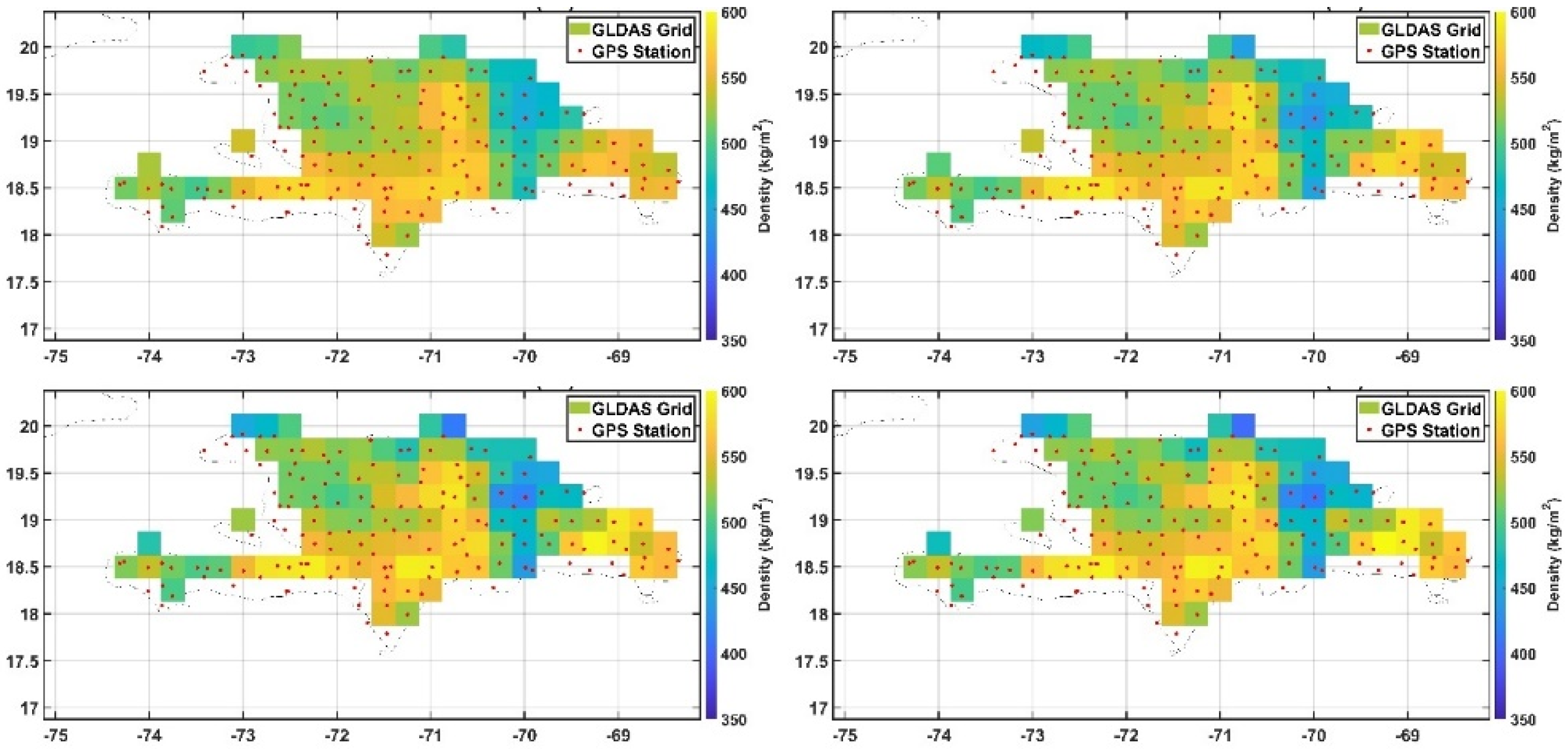
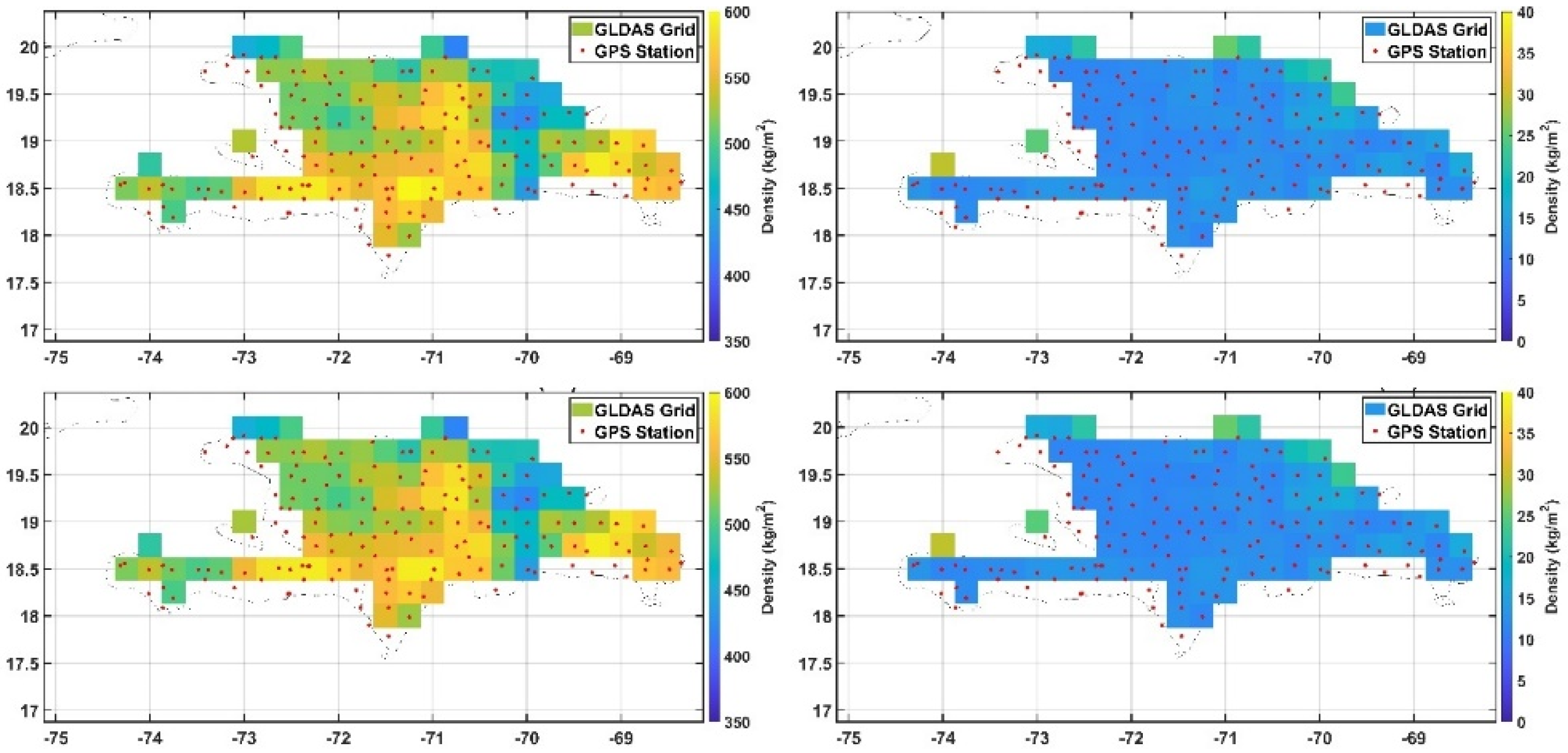
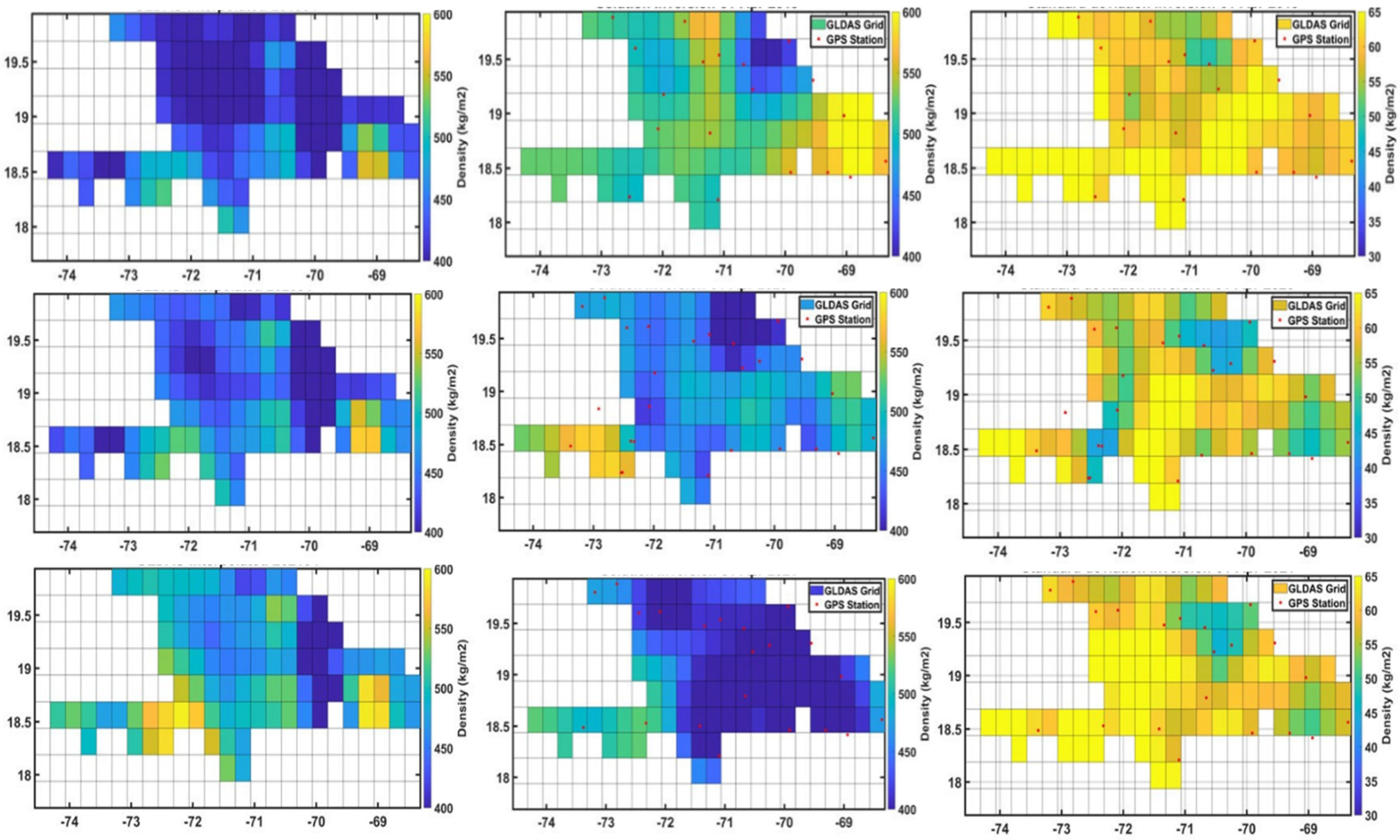

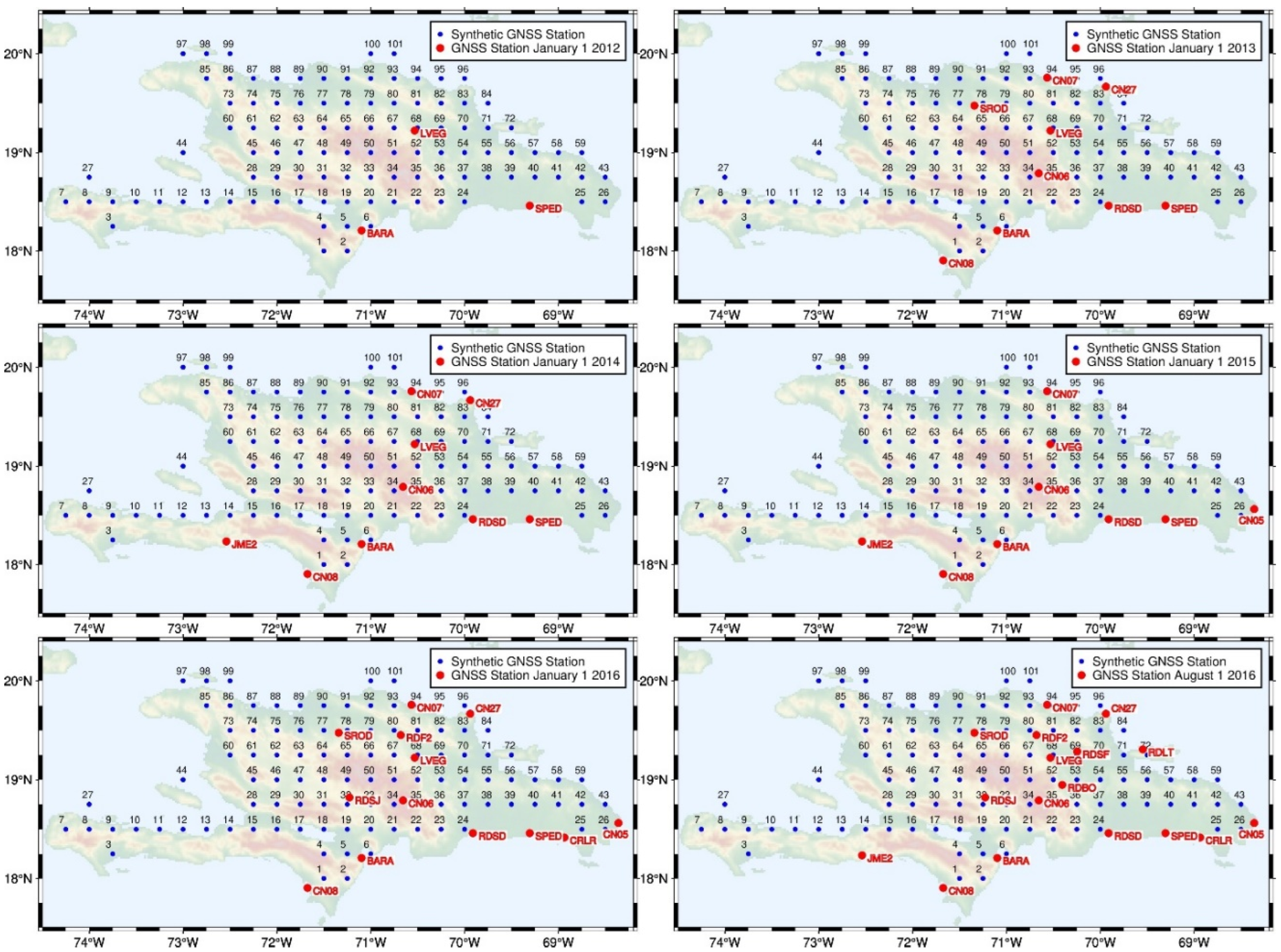
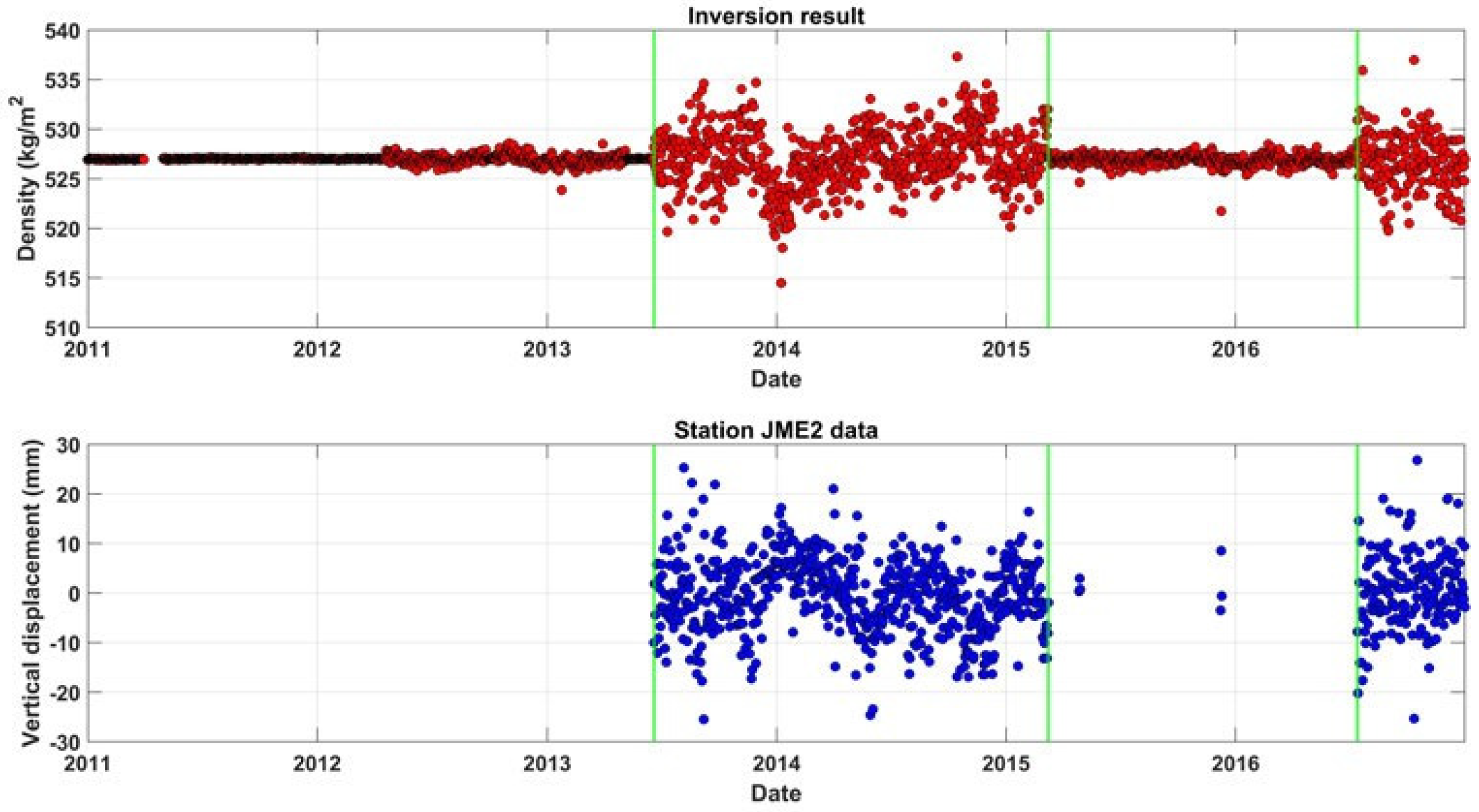

| Covariance Models | ||
|---|---|---|
| Name | Function | Reference |
| Gaussian | [38] | |
| Hirvonen | [39] | |
| Exponential | [40] | |
| Exponential | [41] | |
| RMSE (kg/m2) | Reduction (%) | Correlation | |
|---|---|---|---|
| Gauss [38] | 116.5 | 75.5 | 0.06 |
| Exponential [41] | 104.91 | 77.9 | 0.078 |
| Exponential (ln2) [40] | 121.48 | 74.6 | 0.089 |
| Hirvonen [39] | 223.10 | 53.87 | 0.15 |
| Error (Fraction svd) | Max Difference (kg/m2) | Min Difference (kg/m2) | RMSE (kg/m2) | Correlation (%) | Reduction (%) |
|---|---|---|---|---|---|
| 1/1 | 149 | −121 | 48 | 75.26 | 91 |
| 1/3 | 131 | −101 | 42 | 81.9 | 92 |
| 1/6 | 117 | −99 | 39 | 83.76 | 93 |
| 1/9 | 112 | −97 | 38 | 84 | 93 |
| Error (Fraction svd) | Max Difference (kg/m2) | Min Difference (kg/m2) | RMSE (kg/m2) | Correlation (%) | Reduction (%) |
|---|---|---|---|---|---|
| 100 | 120 | −96 | 40 | 83 | 93 |
| 1/5 | 120 | −100 | 40 | 83 | 92 |
Disclaimer/Publisher’s Note: The statements, opinions and data contained in all publications are solely those of the individual author(s) and contributor(s) and not of MDPI and/or the editor(s). MDPI and/or the editor(s) disclaim responsibility for any injury to people or property resulting from any ideas, methods, instructions or products referred to in the content. |
© 2025 by the authors. Licensee MDPI, Basel, Switzerland. This article is an open access article distributed under the terms and conditions of the Creative Commons Attribution (CC BY) license (https://creativecommons.org/licenses/by/4.0/).
Share and Cite
Sauveur, R.; Tabibi, S.; Francis, O. Least Squares Collocation for Estimating Terrestrial Water Storage Variations from GNSS Vertical Displacement on the Island of Haiti. Geosciences 2025, 15, 322. https://doi.org/10.3390/geosciences15080322
Sauveur R, Tabibi S, Francis O. Least Squares Collocation for Estimating Terrestrial Water Storage Variations from GNSS Vertical Displacement on the Island of Haiti. Geosciences. 2025; 15(8):322. https://doi.org/10.3390/geosciences15080322
Chicago/Turabian StyleSauveur, Renaldo, Sajad Tabibi, and Olivier Francis. 2025. "Least Squares Collocation for Estimating Terrestrial Water Storage Variations from GNSS Vertical Displacement on the Island of Haiti" Geosciences 15, no. 8: 322. https://doi.org/10.3390/geosciences15080322
APA StyleSauveur, R., Tabibi, S., & Francis, O. (2025). Least Squares Collocation for Estimating Terrestrial Water Storage Variations from GNSS Vertical Displacement on the Island of Haiti. Geosciences, 15(8), 322. https://doi.org/10.3390/geosciences15080322








